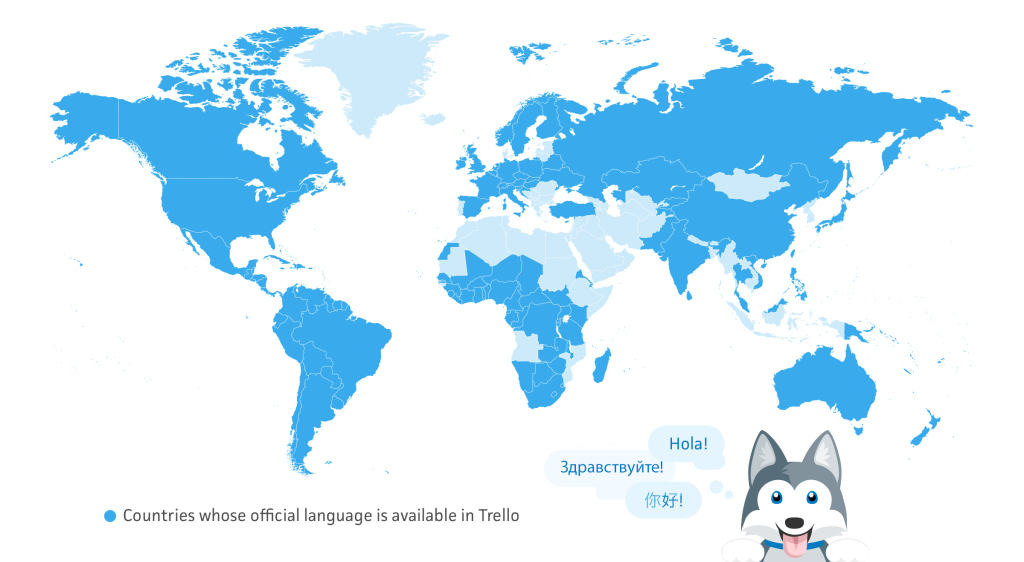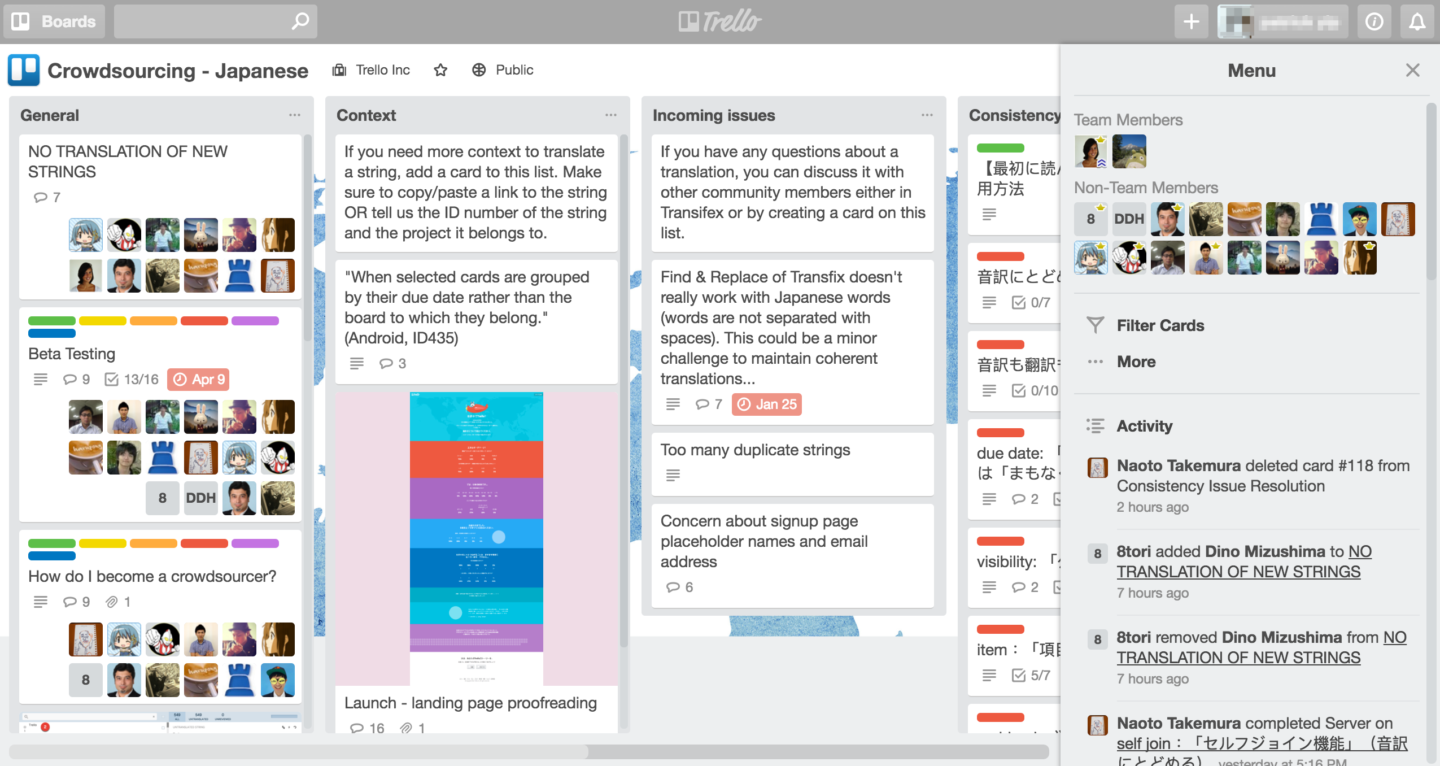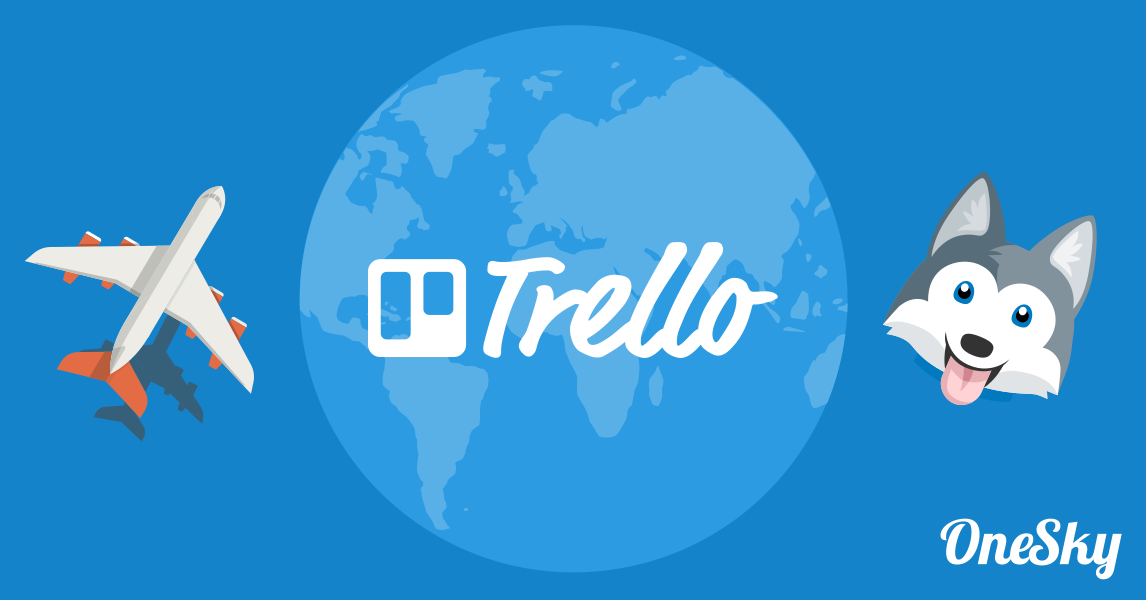Trello Teaches How They Nailed Localization and Global Marketing
Introduction
There are some things that just about everyone loves, no matter where the person comes from. Laughter. Time with someone they care about. A good meal.
And, perhaps, your product.
It’s hard enough to build a software that’s truly universal. But, even when you pull that off, there’s still another set of challenges: making sure people everywhere have heard about your product, and then getting them to actually use it. Many software companies struggle to go truly international; even if they start getting active users from around the globe, few companies know how to leverage this interest to get real traction in new markets.
But some do. Like Trello.
Everyone who uses Trello loves it, and the company recently localized into a total of 20 languages. We had the opportunity to sit down with Alexia, Trello’s International Marketing Lead, and pick her brain about their international expansion strategies. In this blog post, we’re going to share what we learned with you.

Alexia’ll teach us:
- the importance of data and experiments in planning your expansion strategies,
- tricks for leveraging your loyal users to localize your product,
- and the reason why localization goes hand in hand with marketing.
Lesson 1: Data and experiments are your best friends
Numbers don’t lie, and Trello knows that. From the very beginning, the company has started with the data: first, they look at the information they already have, then hypothesize what strategies would be best, and, after that, use experiments to see if they were right. Only then do they get started with the actual plan.
This approach resulted in a three-part localization strategy. First, they conducted two experiments. And, once those proved to be successful, they went for a huge global launch.
Experiment #1: How powerful is localization?
A localization initiative that spans 20 countries takes time, money, and effort. And Trello knew they didn’t want to commit too much of any of those things without being sure that localization would have the greatest possible impact.
Based on user data, the company chose Brazil, Spain, and Germany—three of their most popular markets—as test cases. For each country, they localized the product quickly, using professional translation services. But, when it came to marketing campaigns, they went with three different tactics.
Comparing the results, they found huge differences between the countries. The effectiveness of localization ranged from almost nil, to successfully doubling signups during the launch period. After this first experiment, there was no question that localization could work for Trello—but how they did it would matter.
Experiment #2: What’s the best translation model?
Trello then added a new market to the equation: France. Here, in addition to localizing the product, they capitalized on a number of marketing strategies to drive the number of signups to triple the number they usually would expect during a launch period. Even after the launch had ended, they still found that performance was 25% better than it had been before.
And, beyond taking this opportunity to test even more marketing campaigns, they also experimented with their approach to translation. In France, rather than using professional translators, they tried crowdsourcing the task.
And the results were surprising.
Volunteer translators, whom they recruited, were able to finish 47,000 words of translation within a month….and the quality was much better than expected. Sure, these volunteers made mistakes sometimes, but they were also more familiar with the tone of Trello. The text came out friendly, and with a sense of humor—exactly the voice that Trello prides itself on.
The France experiment was a success. Now that it was clear that volunteers would be eager to help with the translation (and the results would be better for it), Trello was ready to use crowdsourcing for other countries. All that was left was to make it happen.
The Result: Global launch
After the expansion into France, Alexia and the Trello team analyzed all the data to answer a number of questions: how signups varied based on country, which browsers different locals used, what the default languages were on user devices, etc. Based on this analysis, they selected dozens of languages to translate. And then, they got down to business.
There was a flurry of hard work—crowdsourced translation, troubleshooting, collaborating with local markets—and, in just four months, they were ready. Trello rolled out a global launch with 16 new languages: Finnish, Norwegian, Swedish, Russian, Polish, Hungarian, Ukrainian, Czech, Dutch, Italian, Turkish, Thai, Japanese, Traditional Chinese, Simplified Chinese, and Vietnamese. Add in the languages they localized during their experiments (Spanish, German, Portuguese, and French), and you end up with the coverage shown in the map below.

It’s a big world, and Trello is now easily accessible to most of it. That’s no small feat.
Tip: Use with your own data
Trello already had a strong user base—which meant that they also already had access to a wealth of data. That’s the perfect starting point for a global push. Alexia explains, “Instead of looking for what [languages] you want to have, choose the languages that your users really want. When you have a sizable community, you can understand what languages your users really want. Instead of wasting time on languages that people wouldn’t actually use, choose those….”
By starting and experimenting with information specific to your app, you’re going to create a strategy that responds to your users’ needs. Plus, choosing languages that your users already know—and finding ways for them to feel invested in your product—can have other advantages. Alexia notes, “Crowdsourcers can do a lot of things, because we have a very engaged community.”
Alexia should know. Trello’s users did all the translations for their global launch—for free.
Lesson 2: Crowdsourcing = love
Crowdsourcing gets a lot of flak. All you have to do is say the word to some people, and you’ll get a speech about poor translation quality, unfair treatment of volunteers, etc.
Alexia is definitely not one of those people. When Trello started crowdsourcing, the company ended up getting an incredible amount of positive attention from the Trello community. Their product has been free since the beginning, and it turned out that their users felt a lot of gratitude—even love—for the product and the company.
“I was once at a tourist spot in Mexico with my Trello tee,” Alexia remembers. “I was so surprised that there were people lined up behind me and [they] asked for…photos, just because they use Trello and love it.”
And people don’t just love Trello—they want to help. Alexia adds, “What we learned from French localization was that we could translate easily with crowdsourcing, and people are interested in doing that. And we realized, we could actually open any language [within the community].”
Now, they’ve recruited anywhere from 30 to 50 translators for each language, working with a total of 520 people to build and maintain the 17 languageshey’ve translated via crowdsourcing. And they’ve made the requirements simple. To participate in Trello’s crowdsourcing, you simply have to be (a) a native speaker of the target language, (b) able to communicate in English, and (c) an active Trello user.
This system works. To localize Trello into a new language, approximately 47,000 words have to be translated. That means that, in that four-month period of localization, a total of 800,000 words of translation were produced—and almost all of it was done by volunteers.
Crowdsourcing does come with some challenges, though. In this section, we’ll lay out some tips and tools for proper product (and translator) management.
Use the right tools and workflow
Eight hundred thousand words, four months, 16 languages (French was already completed), and 520 people—with numbers like that, Trello’s project could have been a headache. This is especially true because volunteers were involved. As passionate and kind as your contributors may be, the whole setup can feel like it will collapse at any second.
That is, unless you have great tools and smart workflows. With the right systems, Trello was able to pull off this project with incredible success.
Tool #1: A Translation Management System
Trello has found that the best tool is a translation management system (TMS), which is crucial for the localization process. A TMS automatically imports any new content in the original language (in Trello’s case, English) from the relevant website or app; when the translation is done, the TMS drops this new text back into the product. That means, as soon as new content appears, the crowdsourcers—or professional translators, if you go that route—are notified, and they can use the built-in translation tool to work with the content then and there.
When a TMS does these tasks, you don’t have to. Since the TMS automates so many steps of the localization process, you save both management and development time—which helped Trello turn around its launch in a matter of months.
Tool #2: Trello
For product management and communication, Trello has exactly the tool it needs in, well, Trello.
Alexia uses her own product to manage localization projects. She’s created a Trello board for each language, and adds the volunteer translators to these spaces. On each Trello board, she can share instructions, project timelines, and the translation glossary. For the translators, it’s great because they can discuss the work they’re doing; for Alexia, it’s great because she can receive notifications about all the projects in one place. (And, of course, what’s better than having translators build comfort with the very product that they’re helping to present?)

Trello’s crowdsourcing translation dashboard
Alexia has assembled just the right toolbox to make localization a breeze—for her, and for her translators as well.
Motivate your volunteers
When you crowdsource a project, you’re counting on people to contribute because they love your product. That’s great.
But it’s also not a contract. Your volunteers can withdraw from a project at any time, or ease off on their commitment, and there’s nothing you can do once they’ve decided that they want to quit.
So, it’s important to make sure they don’t want to quit—and that means rewards. Alexia noticed that, in the first two weeks, her volunteers were eager to contribute. But, after that, they would often become less passionate about the project. That’s when they needed a boost, and Alexia delivered. Here are her two tricks:
- Set a clear deadline. When your translators know what size project they’re dealing with—and how much time they have until it needs to be done—it allows them to schedule the work in the way that makes the most sense for them…and it allows you to get your text translated in time.
- Give rewards. Alexia knows her volunteers love Trello. (Why else would they be doing this?) So she rewards the most productive translators with Trello Gold, the company’s premium plan, for free.
Enhance translation quality
Not everyone loves crowdsourcing, and it’s often criticized for producing poor results. But Alexia argues that translation errors are, in fact, inevitable no matter which method you use. “Professional translations services could also have mistakes,” she notes. “The question is whether you implement good quality measures.”
And, if your quality measures are good, then the resulting translations won’t simply be equal to professional work—they’ll be better. The advantage of crowdsourcing is that the translators are actually familiar with the product. Alexia explains, “Trello is famous for its humorous and friendly voice. Crowdsourcers can capture Trello’s voice more easily and reflect it in their translation.”
Tool #1: A translation glossary
So, wait. What quality measure should you be using? Two words: translation glossary.
A translation glossary is a collection of the key terms in the source language. It improves translation quality by keeping translations consistent (and it speeds up the whole process). And Trello takes the task of creating it very, very seriously.
Instead of using all their volunteers to crowdsource this part, Trello generally asks only local bloggers and journalists—people who have already been writing about Trello in their local language—for help with developing the translation glossary. Trello works with them to nail down the official translation for a couple different types of terms: the words that will be used for key features (such as “boards” and “cards”), and words that clearly need to have a consistent translation (such as “download” and “email”).
Tool #2: Context
A translation glossary is important, but it’s not enough on its own. Alexia would also prepare quality assessment materials to ensure that the content for translation comes with plenty of context.
For the product’s content, such as in-app text, she provides information from the development side of Trello. And for the marketing content, such as the website and landing page, she provides the fullest contest, such as a screenshot of the webpage.
And, when translators have a problem, they know not to hide it. In the true spirit of crowdsourcing, there’s a discussion board where they can hash problems out together.
Tool #3: Reviewers and crowdsourcers
So, you have the tools. Who should be using them, so you get the best results? Alexia has the answer for this one too. You need reviewers. And you need a critical mass of translators to make crowdsourcing successful.
Reviewers have more responsibilities than your average participant. They’re the ones who will check the quality of work, and they will ensure that there is consistency across all the translations. For each language, you should have three or four reviewers, who are chosen from the group of translators.
With a critical mass of crowdsourcing participants, you’ll also have additional, built-in reviewers. “When your crowdsourcers reach a critical mass, they are actually able to review each other’s translation and spot translation errors,” Alexia says “The translation will only get better and better.”
Remember that you can combine translation methods
No matter how well organized you are, though, sometimes the deadline comes before you’re ready. As the end of Alexia’s four months of efforts approached, she realized that they were not going to finish some of the Asian languages on time. So, she switched to professionals.
“Professional translation services are reliable when it comes to service delivery,” Alexia says. Being willing to use a mixture of translation styles also means that you can choose the right people for the right project. For example, when it comes to Trello’s updates to users, she uses professional services. “Trello ships on a weekly basis. They really cannot count on crowdsourcers’ passion to keep up the pace.”
Coordinate with the dev side
Trello’s localization project was big. That wasn’t only because it involved a lot of text; it also covered a lot of platforms: the Android and iOS apps, the store descriptions for the two app stores, the web app, the website, the Trello shop, and server notifications. For each of these, Trello’s team needed to get content ready for translation, in a process that is known as “internationalization.”
That’s where the devs come in. Alexia works closely with the product’s devs to ensure that content has been extracted correctly, that it will connect to the TMS well, and that, overall, internationalization is done right.
And that’s not an easy task. Languages aren’t universal, and code isn’t able to be either. Take pluralization for example. Different languages have different rules for plural forms. Russian has three ways of pluralizing a word; many Asian languages, such as Japanese and Korean, have none. Alexia and the dev team had to work together to create new strings that would support different patterns of pluralization.
They were able to tackle some of the problems, but not all. Other issues, like the role of gender in some languages, or the fact that some languages read from right to left, were not dealt with in the internationalization process. For these, Alexia has to work with her translators to fix them (e.g. asking them to use gender-neutral translations). But, with close coordination, Trello will be able to fix these issues too—one at a time.
Lesson 3: Localization and marketing work together
Translation is just a starting point
For the most part, Trello is a free tool. So, when choosing marketing strategies, the company has learned to focus on tactics that foster organic growth, rather than paid acquisition. And, when you think about it, localization itself is a great organic growth strategy. (It’s so much more appealing to use an app in your own language!)
But translation is just a start. According to Alexia, “A big lesson we learned from the first experiment stage was that only being available in local languages is not enough.”
We mentioned earlier that Trello started their localization project by testing it out in three countries: Brazil, Spain, and Germany. In each, they tried a different marketing tactic. For example, Brazil saw a huge investment in local PR and content marketing, while Spain received only the translated content. Turns out that there wasn’t much of a change in signups in Spain—while Brazil got twice as many as would normally be expected.
You can’t assume that users will magically discover that your app is now available in their language. “To make localization successful, you have to tell the local users that these languages are available,” says Alexia.
So, when they expanded to France for further testing, they scaled up the marketing effort even more. They invested in content marketing. They held more than forty events. They recruited local ambassadors. The C-suites even flew to France twice to promote Trello.
Basically, they did a lot. And they got a lot in return: triple the normal signups during the launch period, and, even after the launch, they continued to do 25% better than they had been. It was clear that Trello had a plan that worked.
In Brazil, they’ve also tried something else: a localized blog. Rather than just having the company’s posts translated into English, they also recruit local bloggers to write original posts. And the content, as a result, is just right for the region.
For global users, use global content marketing
Localization is all about, well, the local, but it’s also about the global. When Trello was preparing for their worldwide launch, they made sure to craft high-quality content that would appeal to a broad base of users (and potential users!). The result: an exciting landing page, made especially to promote the global launch.
The page includes the results from a recent survey the company conducted about its users’ work habits and productivity hacks, illustrated through a series of appealing infographics. Toss in a lot of PR and local marketing, and you have the makings of an international splash.

Infographics on Trello’s global launch page
In the future, Alexia wants to go even further, scaling up the global marketing efforts through tactics such as international SEO and stronger local marketing teams. She also wants to increase the number of services that have been translated, expanding localization efforts to the help desk and a welcome email, so that users will become even more engaged.
Wrap up
Trello may be just one company, but the strategy they developed—like them—could quickly become universal. Alexia gave us three main takeaways:
- When planning your expansion strategies, start with data and experiments.
- Consider crowdsourcing the translation process. When done right, it can yield impressive results.
- Leverage the impact of localization with smart content marketing.
Want to know more about how to kick-start localization? Check out OneSky’s guide to app localization. We walk you through everything you could possibly want to know about the process, from start to finish. And, if you’re already familiar with the basics, the guide is still worth a look: it goes in-depth on specific challenges of localization, from how to collect the best market data to step-by-step instructions for internationalization.
Thank you for reading!

About Alexia Ohannessian
Alexia leads international marketing at Trello, where she recently launched the product in 21 languages through an innovative crowdsourcing effort. She has previously helped numerous companies create expansion strategies for Latin America. Alexia has lived and worked in three different continents. She is originally from France and lives in Brazil. Follow her (@AlexiaO_ian) on Twitter and connect with her on LinkedIn.

About Trello
Trusted by millions, Trello is a visual collaboration tool that creates a shared perspective on any project. Trello’s boards, lists and cards enable you to organize and prioritize
your personal and work life in a fun, flexible, and rewarding way.




 Written by -
Written by - 


 Written by
Written by 



1 Response
[…] Localization without promoting it locally is like laying the fuse without lighting it. It seems Trello’s experience is remarkably similar. […]